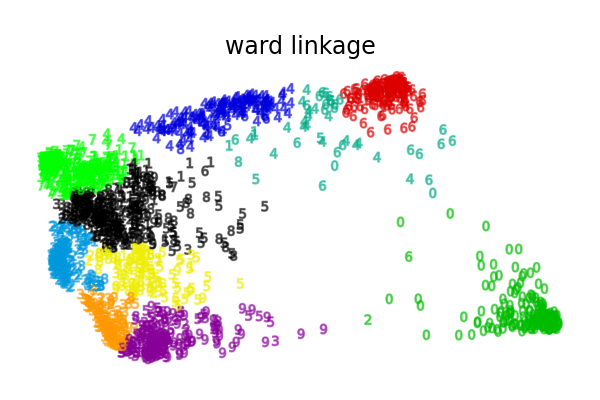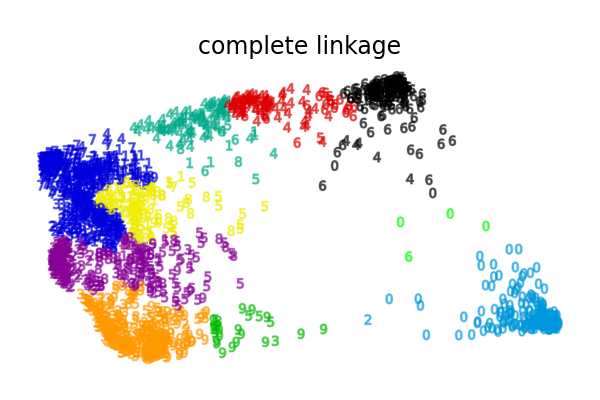Note
Go to the end to download the full example code. or to run this example in your browser via Binder
二维嵌入数字的各种凝聚聚类#
在数字数据集的二维嵌入上展示各种凝聚聚类的链接选项。
此示例的目的是直观地展示度量的行为,而不是为数字数据集找到好的聚类。这就是为什么示例在二维嵌入上进行。
这个示例向我们展示了凝聚聚类的“富者愈富”行为,倾向于创建不均匀的聚类大小。
这种行为在平均链接策略中尤为明显,最终会形成几个数据点较少的聚类。
单链接的情况甚至更为病态,形成一个覆盖大多数数字的非常大的聚类,一个中等大小(干净)的聚类包含大多数零数字,其他所有聚类则由边缘噪声点组成。
其他链接策略导致更均匀分布的聚类,因此更不容易受到数据集随机重采样的影响。
Computing embedding
Done.
ward : 0.04s
average : 0.02s
complete : 0.02s
single : 0.04s
# 作者:scikit-learn 开发者
# SPDX-License-Identifier: BSD-3-Clause
from time import time
import numpy as np
from matplotlib import pyplot as plt
from sklearn import datasets, manifold
digits = datasets.load_digits()
X, y = digits.data, digits.target
n_samples, n_features = X.shape
np.random.seed(0)
# ----------------------------------------------------------------------
# 可视化聚类
def plot_clustering(X_red, labels, title=None):
x_min, x_max = np.min(X_red, axis=0), np.max(X_red, axis=0)
X_red = (X_red - x_min) / (x_max - x_min)
plt.figure(figsize=(6, 4))
for digit in digits.target_names:
plt.scatter(
*X_red[y == digit].T,
marker=f"${digit}$",
s=50,
c=plt.cm.nipy_spectral(labels[y == digit] / 10),
alpha=0.5,
)
plt.xticks([])
plt.yticks([])
if title is not None:
plt.title(title, size=17)
plt.axis("off")
plt.tight_layout(rect=[0, 0.03, 1, 0.95])
# ----------------------------------------------------------------------
# 数字数据集的二维嵌入
print("Computing embedding")
X_red = manifold.SpectralEmbedding(n_components=2).fit_transform(X)
print("Done.")
from sklearn.cluster import AgglomerativeClustering
for linkage in ("ward", "average", "complete", "single"):
clustering = AgglomerativeClustering(linkage=linkage, n_clusters=10)
t0 = time()
clustering.fit(X_red)
print("%s :\t%.2fs" % (linkage, time() - t0))
plot_clustering(X_red, clustering.labels_, "%s linkage" % linkage)
plt.show()
Total running time of the script: (0 minutes 1.114 seconds)
Related examples








